Holmes Institute HI6006 Competitive Strategy: Strategy Models Essay
VerifiedAdded on 2022/11/29
|7
|1658
|233
Essay
AI Summary
This essay provides a comprehensive analysis of four crucial strategic models: PESTEL analysis, Porter's Five Forces, SWOT analysis, and the Ansoff Matrix. The PESTEL analysis examines the macro-environmental factors impacting a business, including political, economic, social, technological, environmental, and legal considerations. Porter's Five Forces model assesses industry competitiveness by evaluating the threat of new entrants, the bargaining power of suppliers and consumers, the threat of substitutes, and the rivalry among existing competitors. SWOT analysis evaluates a company's internal strengths and weaknesses alongside external opportunities and threats, aiding in strategic planning. Lastly, the Ansoff Matrix explores growth strategies, including market penetration, market development, product development, and diversification. The essay provides a detailed explanation of each model along with its practical application to current business examples, which is required by the assignment brief.
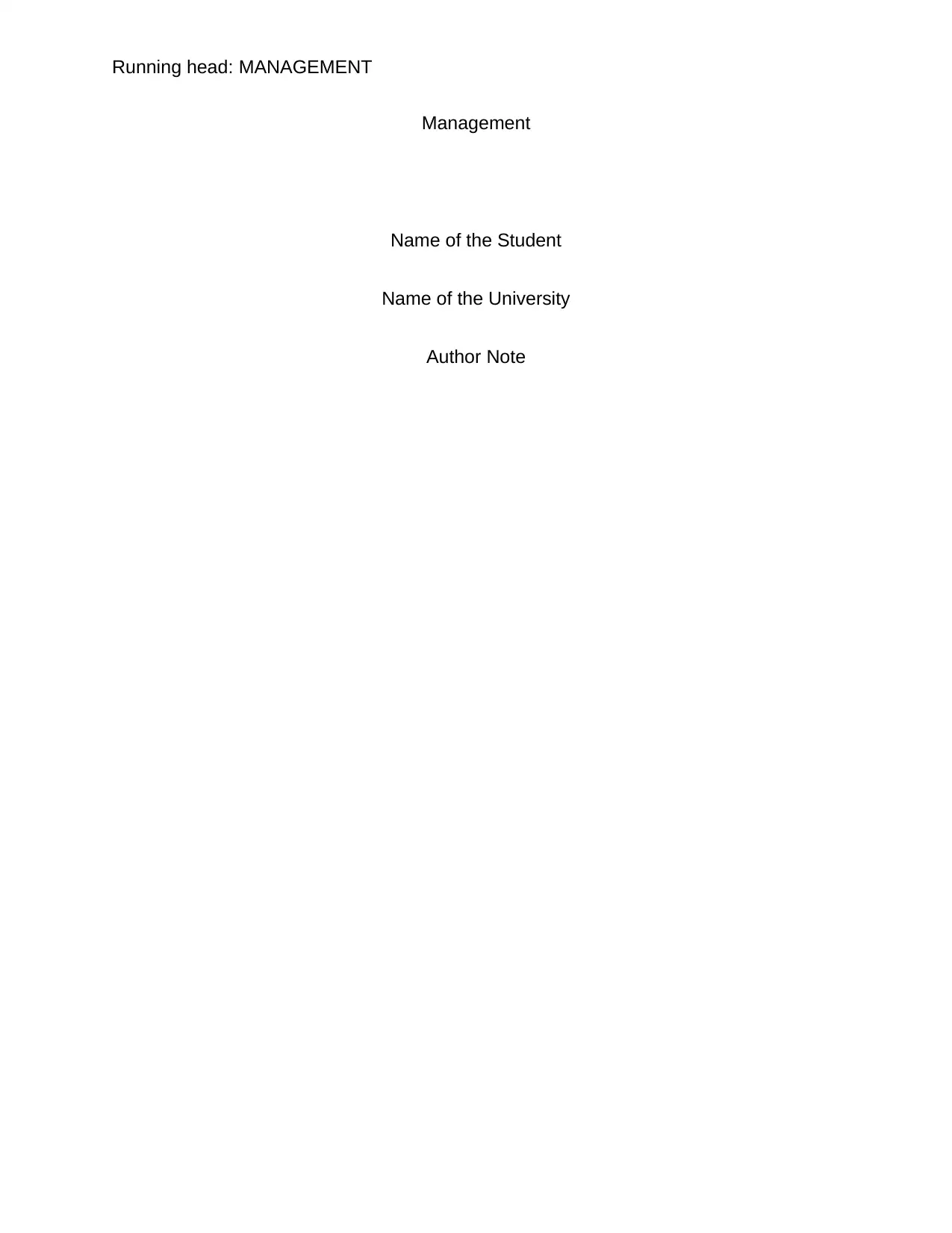
Running head: MANAGEMENT
Management
Name of the Student
Name of the University
Author Note
Management
Name of the Student
Name of the University
Author Note
Paraphrase This Document
Need a fresh take? Get an instant paraphrase of this document with our AI Paraphraser
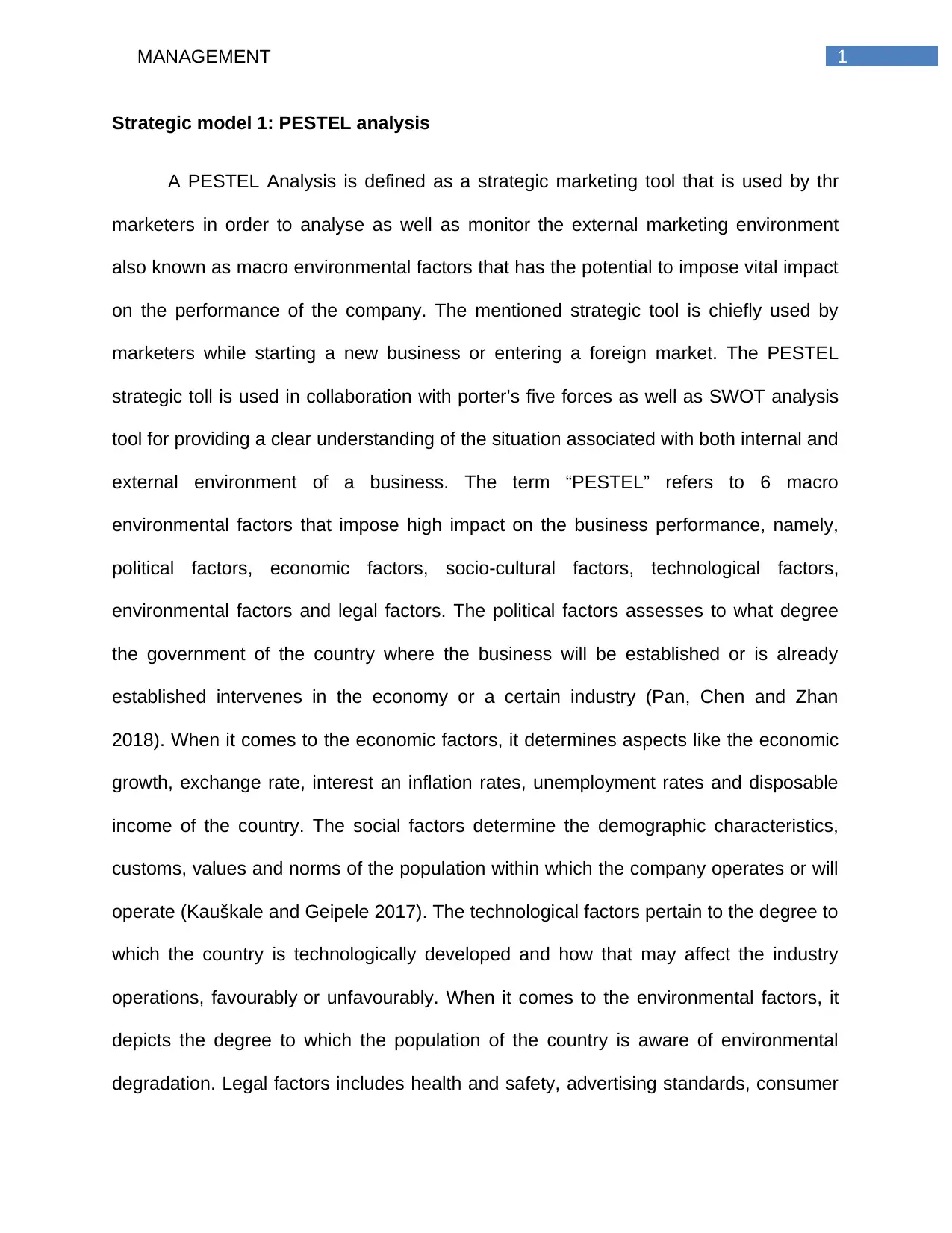
1MANAGEMENT
Strategic model 1: PESTEL analysis
A PESTEL Analysis is defined as a strategic marketing tool that is used by thr
marketers in order to analyse as well as monitor the external marketing environment
also known as macro environmental factors that has the potential to impose vital impact
on the performance of the company. The mentioned strategic tool is chiefly used by
marketers while starting a new business or entering a foreign market. The PESTEL
strategic toll is used in collaboration with porter’s five forces as well as SWOT analysis
tool for providing a clear understanding of the situation associated with both internal and
external environment of a business. The term “PESTEL” refers to 6 macro
environmental factors that impose high impact on the business performance, namely,
political factors, economic factors, socio-cultural factors, technological factors,
environmental factors and legal factors. The political factors assesses to what degree
the government of the country where the business will be established or is already
established intervenes in the economy or a certain industry (Pan, Chen and Zhan
2018). When it comes to the economic factors, it determines aspects like the economic
growth, exchange rate, interest an inflation rates, unemployment rates and disposable
income of the country. The social factors determine the demographic characteristics,
customs, values and norms of the population within which the company operates or will
operate (Kauškale and Geipele 2017). The technological factors pertain to the degree to
which the country is technologically developed and how that may affect the industry
operations, favourably or unfavourably. When it comes to the environmental factors, it
depicts the degree to which the population of the country is aware of environmental
degradation. Legal factors includes health and safety, advertising standards, consumer
Strategic model 1: PESTEL analysis
A PESTEL Analysis is defined as a strategic marketing tool that is used by thr
marketers in order to analyse as well as monitor the external marketing environment
also known as macro environmental factors that has the potential to impose vital impact
on the performance of the company. The mentioned strategic tool is chiefly used by
marketers while starting a new business or entering a foreign market. The PESTEL
strategic toll is used in collaboration with porter’s five forces as well as SWOT analysis
tool for providing a clear understanding of the situation associated with both internal and
external environment of a business. The term “PESTEL” refers to 6 macro
environmental factors that impose high impact on the business performance, namely,
political factors, economic factors, socio-cultural factors, technological factors,
environmental factors and legal factors. The political factors assesses to what degree
the government of the country where the business will be established or is already
established intervenes in the economy or a certain industry (Pan, Chen and Zhan
2018). When it comes to the economic factors, it determines aspects like the economic
growth, exchange rate, interest an inflation rates, unemployment rates and disposable
income of the country. The social factors determine the demographic characteristics,
customs, values and norms of the population within which the company operates or will
operate (Kauškale and Geipele 2017). The technological factors pertain to the degree to
which the country is technologically developed and how that may affect the industry
operations, favourably or unfavourably. When it comes to the environmental factors, it
depicts the degree to which the population of the country is aware of environmental
degradation. Legal factors includes health and safety, advertising standards, consumer
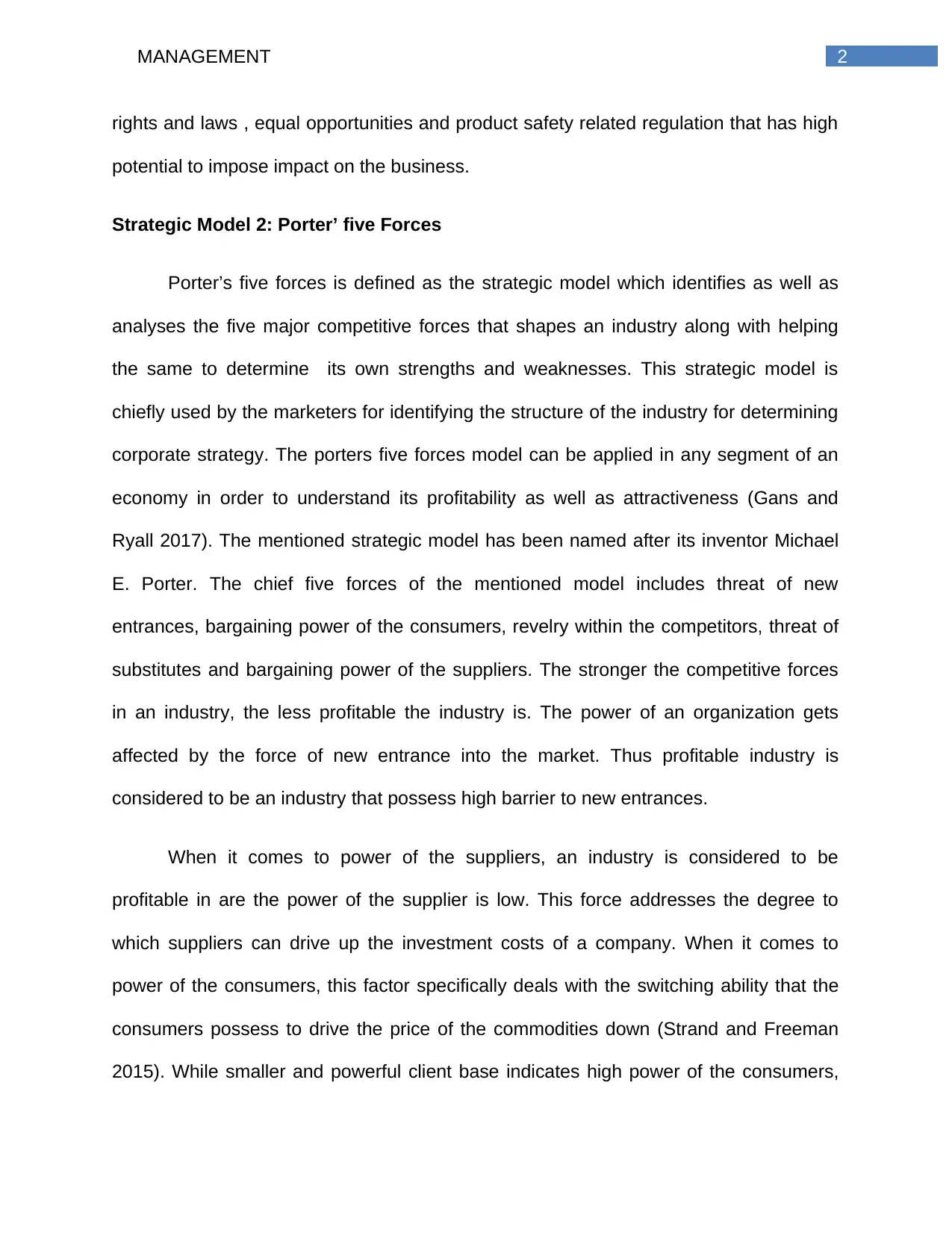
2MANAGEMENT
rights and laws , equal opportunities and product safety related regulation that has high
potential to impose impact on the business.
Strategic Model 2: Porter’ five Forces
Porter’s five forces is defined as the strategic model which identifies as well as
analyses the five major competitive forces that shapes an industry along with helping
the same to determine its own strengths and weaknesses. This strategic model is
chiefly used by the marketers for identifying the structure of the industry for determining
corporate strategy. The porters five forces model can be applied in any segment of an
economy in order to understand its profitability as well as attractiveness (Gans and
Ryall 2017). The mentioned strategic model has been named after its inventor Michael
E. Porter. The chief five forces of the mentioned model includes threat of new
entrances, bargaining power of the consumers, revelry within the competitors, threat of
substitutes and bargaining power of the suppliers. The stronger the competitive forces
in an industry, the less profitable the industry is. The power of an organization gets
affected by the force of new entrance into the market. Thus profitable industry is
considered to be an industry that possess high barrier to new entrances.
When it comes to power of the suppliers, an industry is considered to be
profitable in are the power of the supplier is low. This force addresses the degree to
which suppliers can drive up the investment costs of a company. When it comes to
power of the consumers, this factor specifically deals with the switching ability that the
consumers possess to drive the price of the commodities down (Strand and Freeman
2015). While smaller and powerful client base indicates high power of the consumers,
rights and laws , equal opportunities and product safety related regulation that has high
potential to impose impact on the business.
Strategic Model 2: Porter’ five Forces
Porter’s five forces is defined as the strategic model which identifies as well as
analyses the five major competitive forces that shapes an industry along with helping
the same to determine its own strengths and weaknesses. This strategic model is
chiefly used by the marketers for identifying the structure of the industry for determining
corporate strategy. The porters five forces model can be applied in any segment of an
economy in order to understand its profitability as well as attractiveness (Gans and
Ryall 2017). The mentioned strategic model has been named after its inventor Michael
E. Porter. The chief five forces of the mentioned model includes threat of new
entrances, bargaining power of the consumers, revelry within the competitors, threat of
substitutes and bargaining power of the suppliers. The stronger the competitive forces
in an industry, the less profitable the industry is. The power of an organization gets
affected by the force of new entrance into the market. Thus profitable industry is
considered to be an industry that possess high barrier to new entrances.
When it comes to power of the suppliers, an industry is considered to be
profitable in are the power of the supplier is low. This force addresses the degree to
which suppliers can drive up the investment costs of a company. When it comes to
power of the consumers, this factor specifically deals with the switching ability that the
consumers possess to drive the price of the commodities down (Strand and Freeman
2015). While smaller and powerful client base indicates high power of the consumers,
⊘ This is a preview!⊘
Do you want full access?
Subscribe today to unlock all pages.

Trusted by 1+ million students worldwide
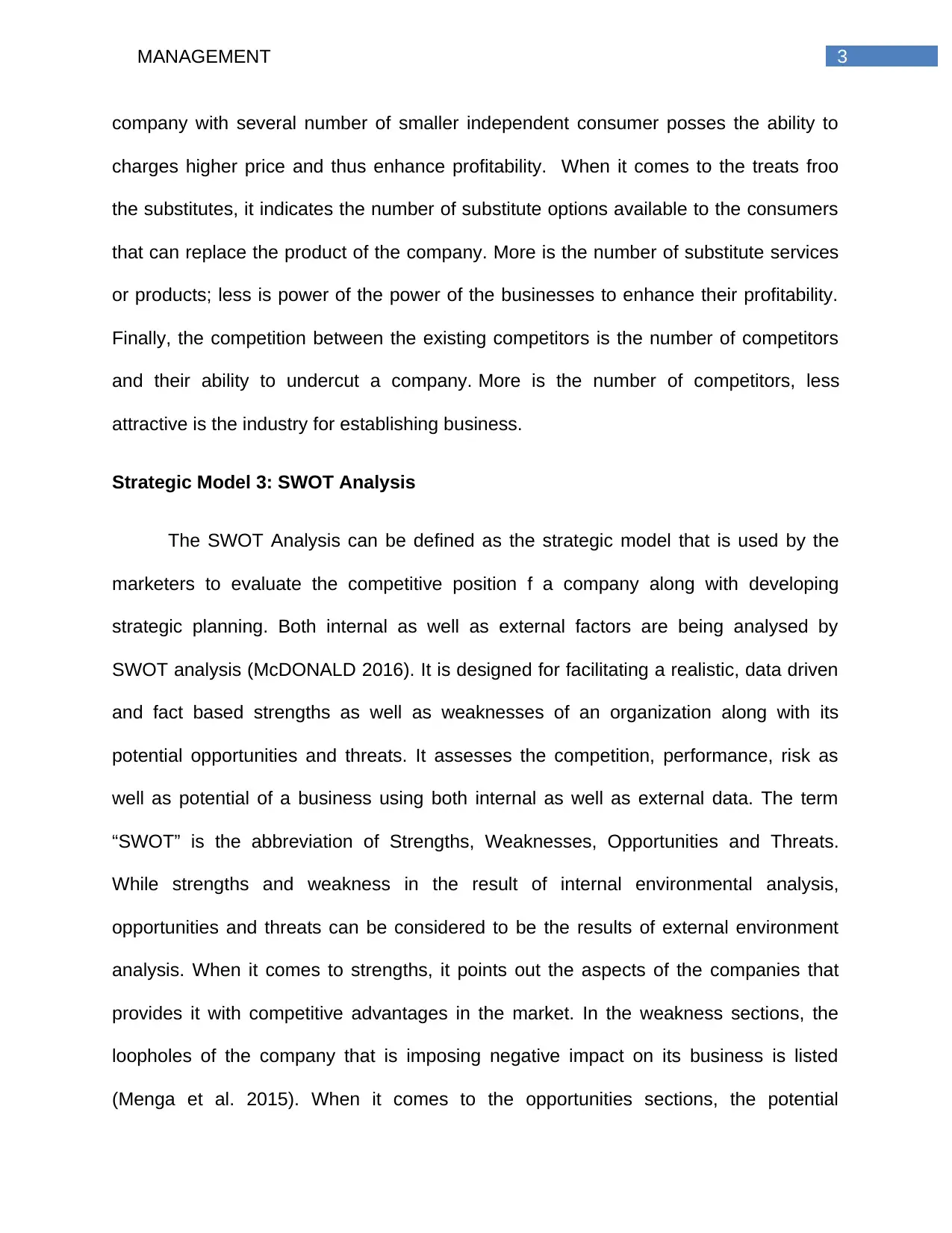
3MANAGEMENT
company with several number of smaller independent consumer posses the ability to
charges higher price and thus enhance profitability. When it comes to the treats froo
the substitutes, it indicates the number of substitute options available to the consumers
that can replace the product of the company. More is the number of substitute services
or products; less is power of the power of the businesses to enhance their profitability.
Finally, the competition between the existing competitors is the number of competitors
and their ability to undercut a company. More is the number of competitors, less
attractive is the industry for establishing business.
Strategic Model 3: SWOT Analysis
The SWOT Analysis can be defined as the strategic model that is used by the
marketers to evaluate the competitive position f a company along with developing
strategic planning. Both internal as well as external factors are being analysed by
SWOT analysis (McDONALD 2016). It is designed for facilitating a realistic, data driven
and fact based strengths as well as weaknesses of an organization along with its
potential opportunities and threats. It assesses the competition, performance, risk as
well as potential of a business using both internal as well as external data. The term
“SWOT” is the abbreviation of Strengths, Weaknesses, Opportunities and Threats.
While strengths and weakness in the result of internal environmental analysis,
opportunities and threats can be considered to be the results of external environment
analysis. When it comes to strengths, it points out the aspects of the companies that
provides it with competitive advantages in the market. In the weakness sections, the
loopholes of the company that is imposing negative impact on its business is listed
(Menga et al. 2015). When it comes to the opportunities sections, the potential
company with several number of smaller independent consumer posses the ability to
charges higher price and thus enhance profitability. When it comes to the treats froo
the substitutes, it indicates the number of substitute options available to the consumers
that can replace the product of the company. More is the number of substitute services
or products; less is power of the power of the businesses to enhance their profitability.
Finally, the competition between the existing competitors is the number of competitors
and their ability to undercut a company. More is the number of competitors, less
attractive is the industry for establishing business.
Strategic Model 3: SWOT Analysis
The SWOT Analysis can be defined as the strategic model that is used by the
marketers to evaluate the competitive position f a company along with developing
strategic planning. Both internal as well as external factors are being analysed by
SWOT analysis (McDONALD 2016). It is designed for facilitating a realistic, data driven
and fact based strengths as well as weaknesses of an organization along with its
potential opportunities and threats. It assesses the competition, performance, risk as
well as potential of a business using both internal as well as external data. The term
“SWOT” is the abbreviation of Strengths, Weaknesses, Opportunities and Threats.
While strengths and weakness in the result of internal environmental analysis,
opportunities and threats can be considered to be the results of external environment
analysis. When it comes to strengths, it points out the aspects of the companies that
provides it with competitive advantages in the market. In the weakness sections, the
loopholes of the company that is imposing negative impact on its business is listed
(Menga et al. 2015). When it comes to the opportunities sections, the potential
Paraphrase This Document
Need a fresh take? Get an instant paraphrase of this document with our AI Paraphraser
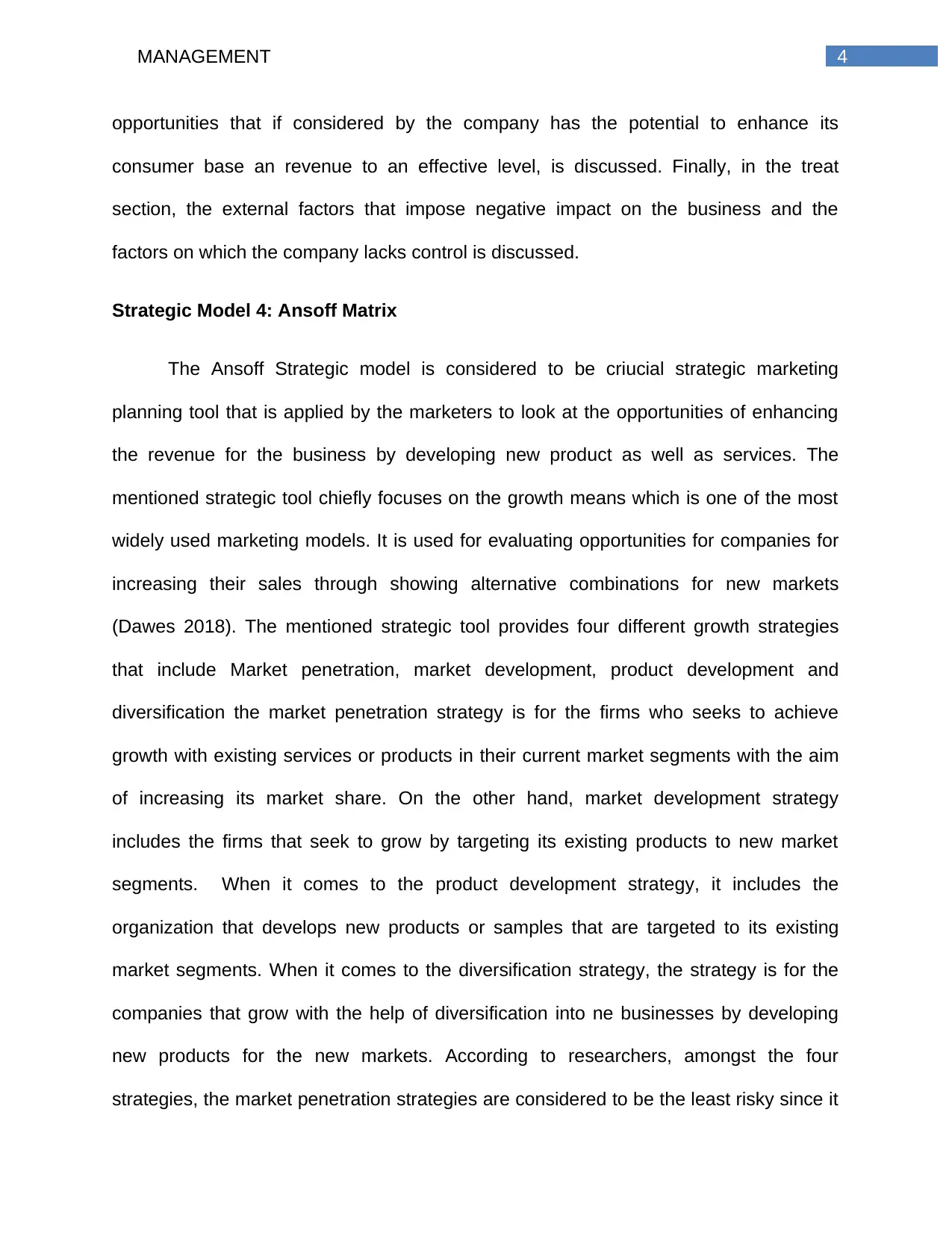
4MANAGEMENT
opportunities that if considered by the company has the potential to enhance its
consumer base an revenue to an effective level, is discussed. Finally, in the treat
section, the external factors that impose negative impact on the business and the
factors on which the company lacks control is discussed.
Strategic Model 4: Ansoff Matrix
The Ansoff Strategic model is considered to be criucial strategic marketing
planning tool that is applied by the marketers to look at the opportunities of enhancing
the revenue for the business by developing new product as well as services. The
mentioned strategic tool chiefly focuses on the growth means which is one of the most
widely used marketing models. It is used for evaluating opportunities for companies for
increasing their sales through showing alternative combinations for new markets
(Dawes 2018). The mentioned strategic tool provides four different growth strategies
that include Market penetration, market development, product development and
diversification the market penetration strategy is for the firms who seeks to achieve
growth with existing services or products in their current market segments with the aim
of increasing its market share. On the other hand, market development strategy
includes the firms that seek to grow by targeting its existing products to new market
segments. When it comes to the product development strategy, it includes the
organization that develops new products or samples that are targeted to its existing
market segments. When it comes to the diversification strategy, the strategy is for the
companies that grow with the help of diversification into ne businesses by developing
new products for the new markets. According to researchers, amongst the four
strategies, the market penetration strategies are considered to be the least risky since it
opportunities that if considered by the company has the potential to enhance its
consumer base an revenue to an effective level, is discussed. Finally, in the treat
section, the external factors that impose negative impact on the business and the
factors on which the company lacks control is discussed.
Strategic Model 4: Ansoff Matrix
The Ansoff Strategic model is considered to be criucial strategic marketing
planning tool that is applied by the marketers to look at the opportunities of enhancing
the revenue for the business by developing new product as well as services. The
mentioned strategic tool chiefly focuses on the growth means which is one of the most
widely used marketing models. It is used for evaluating opportunities for companies for
increasing their sales through showing alternative combinations for new markets
(Dawes 2018). The mentioned strategic tool provides four different growth strategies
that include Market penetration, market development, product development and
diversification the market penetration strategy is for the firms who seeks to achieve
growth with existing services or products in their current market segments with the aim
of increasing its market share. On the other hand, market development strategy
includes the firms that seek to grow by targeting its existing products to new market
segments. When it comes to the product development strategy, it includes the
organization that develops new products or samples that are targeted to its existing
market segments. When it comes to the diversification strategy, the strategy is for the
companies that grow with the help of diversification into ne businesses by developing
new products for the new markets. According to researchers, amongst the four
strategies, the market penetration strategies are considered to be the least risky since it
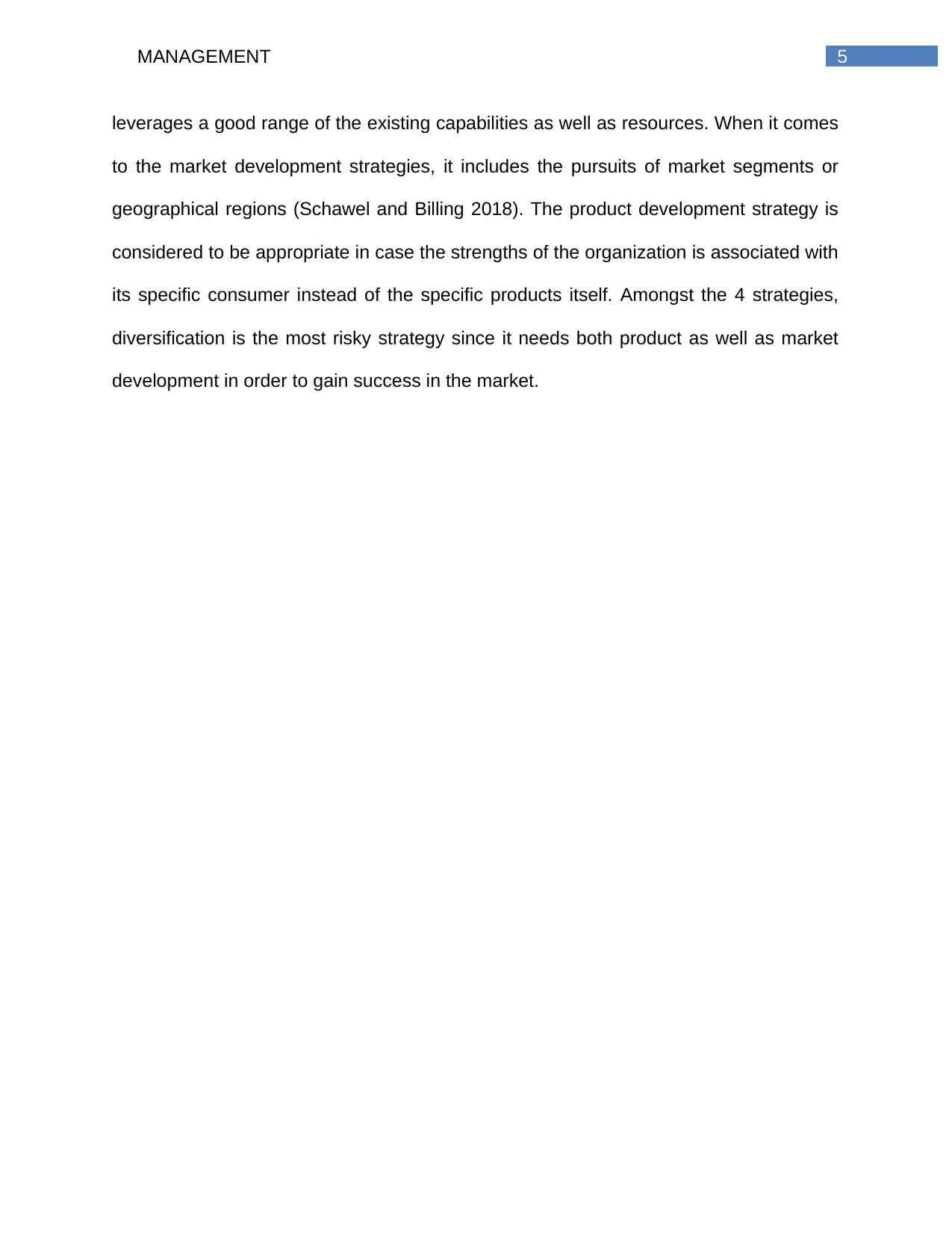
5MANAGEMENT
leverages a good range of the existing capabilities as well as resources. When it comes
to the market development strategies, it includes the pursuits of market segments or
geographical regions (Schawel and Billing 2018). The product development strategy is
considered to be appropriate in case the strengths of the organization is associated with
its specific consumer instead of the specific products itself. Amongst the 4 strategies,
diversification is the most risky strategy since it needs both product as well as market
development in order to gain success in the market.
leverages a good range of the existing capabilities as well as resources. When it comes
to the market development strategies, it includes the pursuits of market segments or
geographical regions (Schawel and Billing 2018). The product development strategy is
considered to be appropriate in case the strengths of the organization is associated with
its specific consumer instead of the specific products itself. Amongst the 4 strategies,
diversification is the most risky strategy since it needs both product as well as market
development in order to gain success in the market.
⊘ This is a preview!⊘
Do you want full access?
Subscribe today to unlock all pages.

Trusted by 1+ million students worldwide
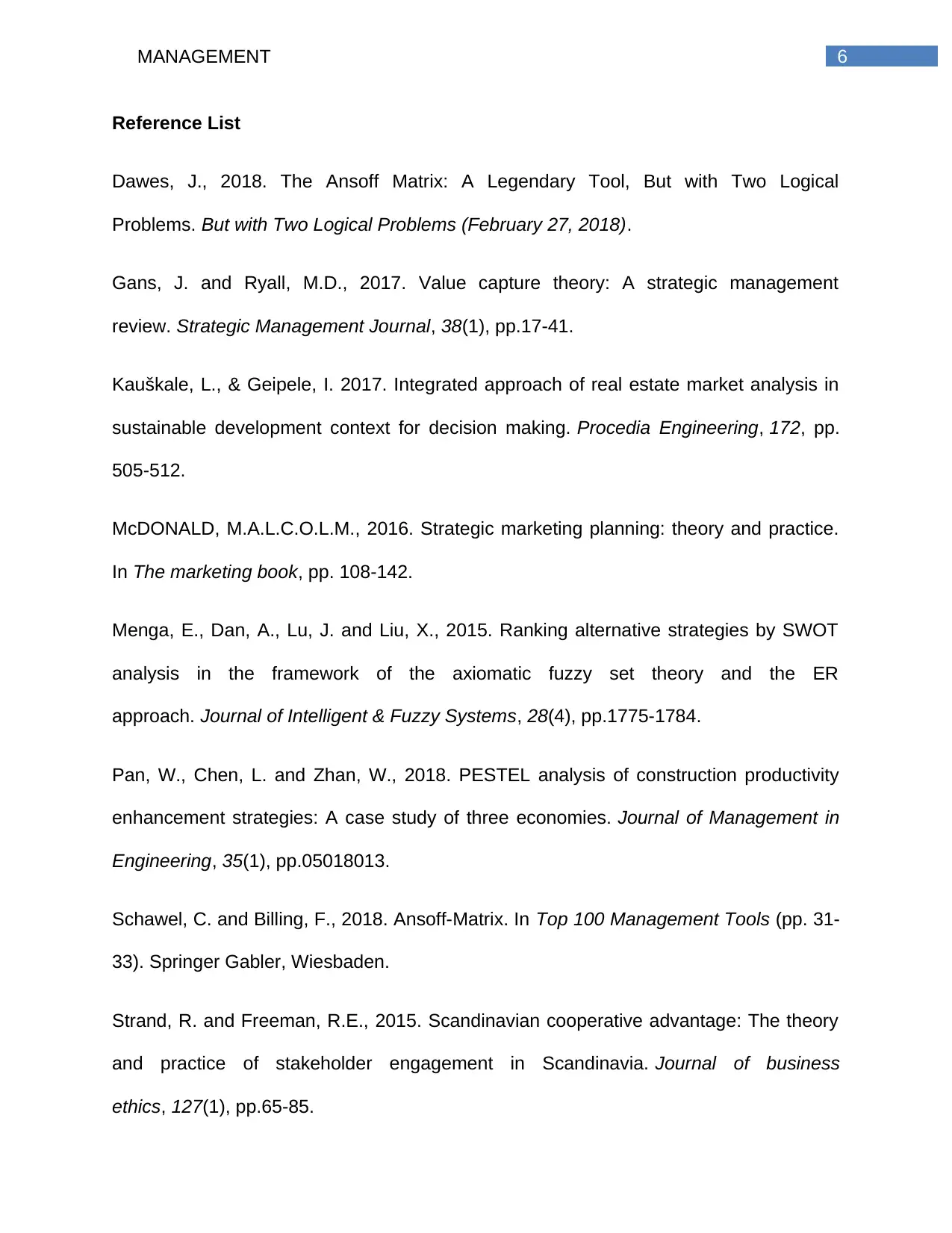
6MANAGEMENT
Reference List
Dawes, J., 2018. The Ansoff Matrix: A Legendary Tool, But with Two Logical
Problems. But with Two Logical Problems (February 27, 2018).
Gans, J. and Ryall, M.D., 2017. Value capture theory: A strategic management
review. Strategic Management Journal, 38(1), pp.17-41.
Kauškale, L., & Geipele, I. 2017. Integrated approach of real estate market analysis in
sustainable development context for decision making. Procedia Engineering, 172, pp.
505-512.
McDONALD, M.A.L.C.O.L.M., 2016. Strategic marketing planning: theory and practice.
In The marketing book, pp. 108-142.
Menga, E., Dan, A., Lu, J. and Liu, X., 2015. Ranking alternative strategies by SWOT
analysis in the framework of the axiomatic fuzzy set theory and the ER
approach. Journal of Intelligent & Fuzzy Systems, 28(4), pp.1775-1784.
Pan, W., Chen, L. and Zhan, W., 2018. PESTEL analysis of construction productivity
enhancement strategies: A case study of three economies. Journal of Management in
Engineering, 35(1), pp.05018013.
Schawel, C. and Billing, F., 2018. Ansoff-Matrix. In Top 100 Management Tools (pp. 31-
33). Springer Gabler, Wiesbaden.
Strand, R. and Freeman, R.E., 2015. Scandinavian cooperative advantage: The theory
and practice of stakeholder engagement in Scandinavia. Journal of business
ethics, 127(1), pp.65-85.
Reference List
Dawes, J., 2018. The Ansoff Matrix: A Legendary Tool, But with Two Logical
Problems. But with Two Logical Problems (February 27, 2018).
Gans, J. and Ryall, M.D., 2017. Value capture theory: A strategic management
review. Strategic Management Journal, 38(1), pp.17-41.
Kauškale, L., & Geipele, I. 2017. Integrated approach of real estate market analysis in
sustainable development context for decision making. Procedia Engineering, 172, pp.
505-512.
McDONALD, M.A.L.C.O.L.M., 2016. Strategic marketing planning: theory and practice.
In The marketing book, pp. 108-142.
Menga, E., Dan, A., Lu, J. and Liu, X., 2015. Ranking alternative strategies by SWOT
analysis in the framework of the axiomatic fuzzy set theory and the ER
approach. Journal of Intelligent & Fuzzy Systems, 28(4), pp.1775-1784.
Pan, W., Chen, L. and Zhan, W., 2018. PESTEL analysis of construction productivity
enhancement strategies: A case study of three economies. Journal of Management in
Engineering, 35(1), pp.05018013.
Schawel, C. and Billing, F., 2018. Ansoff-Matrix. In Top 100 Management Tools (pp. 31-
33). Springer Gabler, Wiesbaden.
Strand, R. and Freeman, R.E., 2015. Scandinavian cooperative advantage: The theory
and practice of stakeholder engagement in Scandinavia. Journal of business
ethics, 127(1), pp.65-85.
1 out of 7
Related Documents
Your All-in-One AI-Powered Toolkit for Academic Success.
+13062052269
info@desklib.com
Available 24*7 on WhatsApp / Email
![[object Object]](/_next/static/media/star-bottom.7253800d.svg)
Unlock your academic potential
Copyright © 2020–2025 A2Z Services. All Rights Reserved. Developed and managed by ZUCOL.





